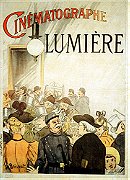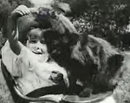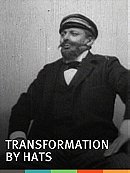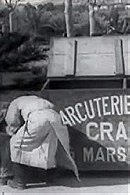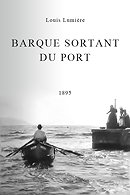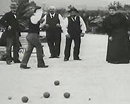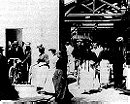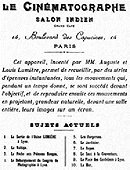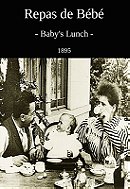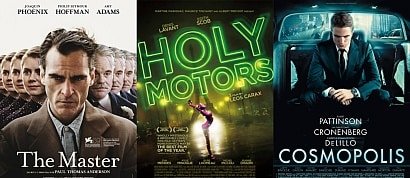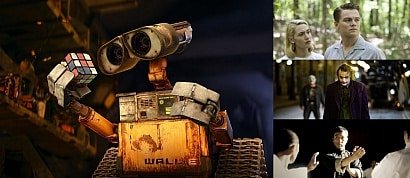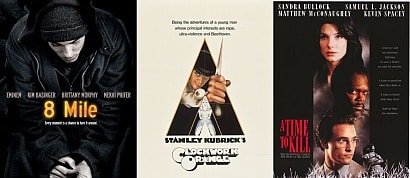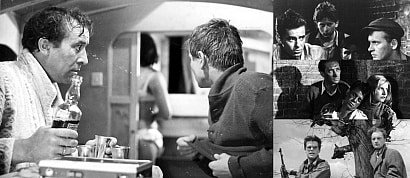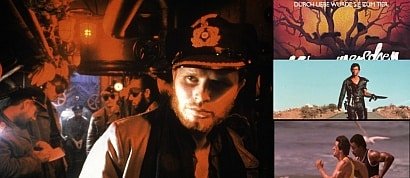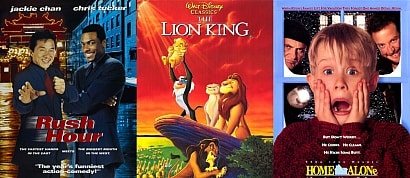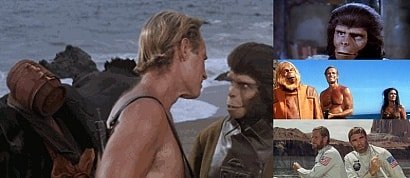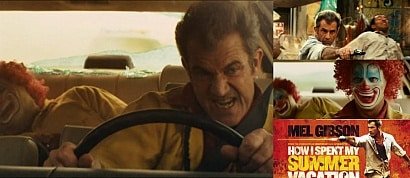Movies 1895
Sort by:
Showing 25 items
Decade:
Rating:
List Type:
Events
February–March - Robert W. Paul and Birt Acres build and run the first working 35 mm movie camera in Britain, the Kineopticon. Their first films include Incident at Clovelly Cottage, The Oxford and Cambridge University Boat Race and Rough Sea at Dover.[1]
In France, the brothers Auguste and Louis Lumière, design and built a lightweight, hand-held motion picture camera called the Cinématographe. They discover that their machine can also be used to project images onto a large screen. The Lumière brothers create several short films at this time that are considered to be pivotal in the history of motion pictures.[1]
February 13 - Auguste and Louis Lumière patent the Cinematographe, a combination movie camera and projector.
March 22 - First display of motion pictures by Auguste and Louis Lumière (private screening).
May 27 - Birt Acres patents the Kineopticon under his own name.
Late September - C. Francis Jenkins and Thomas Armat demonstrate their Phantoscope, a motion picture projector, in Atlanta, Georgia at the Cotton States and International Exposition.
November - In Germany, Emil and Max Skladanowsky develop their own film projector.
December 28 - The Lumière brothers have their first paying audience at the Grand Café Boulevard des Capucines in Paris — this date is sometimes considered the debut of the motion picture as an entertainment medium.
December 30 - The American Mutoscope and Biograph Company motion pictures is founded in New Jersey by the KMCD Syndicate of William Kennedy Dickson, Henry Marvin, Herman Casler and Elias Koopman.
Gaumont Pictures founded by the engineer-turned-inventor, Léon Gaumont. Woodville Latham and his sons develop the Latham Loop - the concept of loose loops of film on either side of the intermittent movement to prevent stress from the jerky movement. This is debuted in the Eidoloscope, which is also the first widescreen format (1.85:1).
Herman Casler of American Mutoscope Company, aka American Mutoscope and Biograph Company manufactures the Biograph 68 mm camera, which will become the first successful large format 68mm (70mm) film.
Henri Joly debuts his Joly-Normandin 60 mm format.
Films released in 1895
Akrobatisches Potpourri
Annabelle Serpentine Dance
L' Arrivée d'un train à La Ciotat
L'Arroseur Arrosé
Autour d'une cabine
Barque sortant du port
Bauerntanz zweier Kinder
Billy Edwards and the Unknown aka Billy Edwards Boxing
La Charcuterie mécanique
The Clown Barber
Das Boxende Känguruh
The Derby
Dickson Experimental Sound Film
The Execution of Mary Stuart
Les Forgerons
Griffo-Barnett Prize Fight
Der Jongleur
La Mer
Opening of the Kiel Canal
The Oxford and Cambridge University Boat Race
Partie de cartes
La Pêche aux poissons rouges
Place des Cordeliers à Lyon
The Photographical Congress Arrives in Lyon
Princess Ali aka Egyptian Dance
Repas de bébé
Rough Sea at Dover
Le Saut à la couverture
Serpentinen Tanz
Sparring Contest at Canastota
La Voltige
Workers Leaving the Lumière Factory
Births
February 7 - Anita Stewart (d.1961)
February 8 - King Vidor (d.1982)
March 17 - Shemp Howard (d.1955)
March 27 - Betty Schade (d. 1982)
April 7 - Margarete Schön (d. 1985)
May 6 - Rudolph Valentino (d. 1926)
July 26 - Gracie Allen (d. 1964)
October 2 - Bud Abbott (d. 1974)
October 4 - Buster Keaton (d. 1966)
October 21 - Edna Purviance (d. 1958)
February–March - Robert W. Paul and Birt Acres build and run the first working 35 mm movie camera in Britain, the Kineopticon. Their first films include Incident at Clovelly Cottage, The Oxford and Cambridge University Boat Race and Rough Sea at Dover.[1]
In France, the brothers Auguste and Louis Lumière, design and built a lightweight, hand-held motion picture camera called the Cinématographe. They discover that their machine can also be used to project images onto a large screen. The Lumière brothers create several short films at this time that are considered to be pivotal in the history of motion pictures.[1]
February 13 - Auguste and Louis Lumière patent the Cinematographe, a combination movie camera and projector.
March 22 - First display of motion pictures by Auguste and Louis Lumière (private screening).
May 27 - Birt Acres patents the Kineopticon under his own name.
Late September - C. Francis Jenkins and Thomas Armat demonstrate their Phantoscope, a motion picture projector, in Atlanta, Georgia at the Cotton States and International Exposition.
November - In Germany, Emil and Max Skladanowsky develop their own film projector.
December 28 - The Lumière brothers have their first paying audience at the Grand Café Boulevard des Capucines in Paris — this date is sometimes considered the debut of the motion picture as an entertainment medium.
December 30 - The American Mutoscope and Biograph Company motion pictures is founded in New Jersey by the KMCD Syndicate of William Kennedy Dickson, Henry Marvin, Herman Casler and Elias Koopman.
Gaumont Pictures founded by the engineer-turned-inventor, Léon Gaumont. Woodville Latham and his sons develop the Latham Loop - the concept of loose loops of film on either side of the intermittent movement to prevent stress from the jerky movement. This is debuted in the Eidoloscope, which is also the first widescreen format (1.85:1).
Herman Casler of American Mutoscope Company, aka American Mutoscope and Biograph Company manufactures the Biograph 68 mm camera, which will become the first successful large format 68mm (70mm) film.
Henri Joly debuts his Joly-Normandin 60 mm format.
Films released in 1895
Akrobatisches Potpourri
Annabelle Serpentine Dance
L' Arrivée d'un train à La Ciotat
L'Arroseur Arrosé
Autour d'une cabine
Barque sortant du port
Bauerntanz zweier Kinder
Billy Edwards and the Unknown aka Billy Edwards Boxing
La Charcuterie mécanique
The Clown Barber
Das Boxende Känguruh
The Derby
Dickson Experimental Sound Film
The Execution of Mary Stuart
Les Forgerons
Griffo-Barnett Prize Fight
Der Jongleur
La Mer
Opening of the Kiel Canal
The Oxford and Cambridge University Boat Race
Partie de cartes
La Pêche aux poissons rouges
Place des Cordeliers à Lyon
The Photographical Congress Arrives in Lyon
Princess Ali aka Egyptian Dance
Repas de bébé
Rough Sea at Dover
Le Saut à la couverture
Serpentinen Tanz
Sparring Contest at Canastota
La Voltige
Workers Leaving the Lumière Factory
Births
February 7 - Anita Stewart (d.1961)
February 8 - King Vidor (d.1982)
March 17 - Shemp Howard (d.1955)
March 27 - Betty Schade (d. 1982)
April 7 - Margarete Schön (d. 1985)
May 6 - Rudolph Valentino (d. 1926)
July 26 - Gracie Allen (d. 1964)
October 2 - Bud Abbott (d. 1974)
October 4 - Buster Keaton (d. 1966)
October 21 - Edna Purviance (d. 1958)
L'Arroseur arrosé (also known as The Waterer Watered and The Sprinkler Sprinkled) is an 1895 French short black-and-white silent comedy film directed and produced by Louis Lumière and starring François Clerc and Benoît Duval. It was first screened on June 10, 1895.
It has the distinction of being the earliest known instance of film comedy, as well as the first use of film to portray a fictional story. The film was originally known as "Le Jardinier" (The Gardener) or "Le Jardinier et le petit espiègle", and is sometimes referred to in English as "The Tables Turned on the Gardener", and "The Sprinkler Sprinkled".
Plot
Shot in Lyon in the spring of 1895, the film portrays a simple practical joke in which a gardener is tormented by a boy who steps on the hose that the gardener is using to water his plants, cutting off the water flow. When the gardener tilts the nozzle up to inspect it, the boy releases the hose, causing the water to spray him. The gardener is stunned and his hat is knocked off, but he soon catches on. A chase ensues, both on and off-screen (the camera never moves from its original position) until the gardener catches the boy and administers a spanking. The entire film lasts only 49 seconds, but this simple bit of slapstick may be the forerunner of all subsequent film comedy.[1]
Production
In the earliest years of the history of film, the cinema was used by pioneers such as Thomas Edison and the Lumières to entertain by the sheer novelty of the invention, and most films were short recordings of mundane events, such as a sneeze, or the arrival of a train. Ever seeking to innovate, the Lumières took some of the first steps toward narrative film with L'Arroseur arrosé. Given the documentary nature of existing films up until this point, a scripted, comedic film shown among these was unexpected by an audience, enhancing its comedic surprise value.
It was filmed by means of the Cinématographe, an all-in-one camera, which also serves as a film projector and developer. As with all early Lumière movies, this film was made in a 35 mm format with an aspect ratio of 1.33:1.
Cast
Louis Lumière used his own gardener, François Clerc, to portray the gardener. For the mischievous boy, Lumière used a young apprentice carpenter from the Lumière factory who is variously credited as Daniel Duval and Benoît Duval. But Léon Trotobas seems to have been the first boy to play the role in La Ciotat.
François Clerc as Gardener
Léon Trotobas, then Benoît Duval as Boy (sometimes credited as Daniel Duval)
The poster
The poster for L'Arroseur arrosé has the distinction of being the first poster ever designed to promote an individual film. Although posters had been used to advertise cinematic projection shows since 1890, these early posters were typically devoted to describing the quality of the recordings and touting the technological novelty of these shows.[5] The poster for L'Arroseur, illustrated by Marcellin Auzolle, depicts an audience (in the foreground) laughing as the film (in the background) is projected against a screen. It depicts the moment the gardener is splashed in the face, and is thus also the first film poster to depict an actual scene from a film.
Copies and Imitations
As copyright law was neither enforced nor yet well-defined for the emerging art of cinema, it was common both for competing filmmakers to reshoot a popular film short and for distributors to duplicate a film print to show as their own. Through these practices, L'Arroseur arrosé was copied several times and released under a number of different titles in both France and the US, including at least one remake by the Lumières, themselves. Little is known about most of these copies, although one known remake was filmed by Georges Méliès, titled L'Arroseur, in 1896. French New Wave director François Truffaut later included an homage to the gag in his 1958 film, Les Mistons.
Current status
Given its age, this short film is available to freely download from the Internet. It has also featured in a number of film collections including Landmarks of Early Film volume 1.
It has the distinction of being the earliest known instance of film comedy, as well as the first use of film to portray a fictional story. The film was originally known as "Le Jardinier" (The Gardener) or "Le Jardinier et le petit espiègle", and is sometimes referred to in English as "The Tables Turned on the Gardener", and "The Sprinkler Sprinkled".
Plot
Shot in Lyon in the spring of 1895, the film portrays a simple practical joke in which a gardener is tormented by a boy who steps on the hose that the gardener is using to water his plants, cutting off the water flow. When the gardener tilts the nozzle up to inspect it, the boy releases the hose, causing the water to spray him. The gardener is stunned and his hat is knocked off, but he soon catches on. A chase ensues, both on and off-screen (the camera never moves from its original position) until the gardener catches the boy and administers a spanking. The entire film lasts only 49 seconds, but this simple bit of slapstick may be the forerunner of all subsequent film comedy.[1]
Production
In the earliest years of the history of film, the cinema was used by pioneers such as Thomas Edison and the Lumières to entertain by the sheer novelty of the invention, and most films were short recordings of mundane events, such as a sneeze, or the arrival of a train. Ever seeking to innovate, the Lumières took some of the first steps toward narrative film with L'Arroseur arrosé. Given the documentary nature of existing films up until this point, a scripted, comedic film shown among these was unexpected by an audience, enhancing its comedic surprise value.
It was filmed by means of the Cinématographe, an all-in-one camera, which also serves as a film projector and developer. As with all early Lumière movies, this film was made in a 35 mm format with an aspect ratio of 1.33:1.
Cast
Louis Lumière used his own gardener, François Clerc, to portray the gardener. For the mischievous boy, Lumière used a young apprentice carpenter from the Lumière factory who is variously credited as Daniel Duval and Benoît Duval. But Léon Trotobas seems to have been the first boy to play the role in La Ciotat.
François Clerc as Gardener
Léon Trotobas, then Benoît Duval as Boy (sometimes credited as Daniel Duval)
The poster
The poster for L'Arroseur arrosé has the distinction of being the first poster ever designed to promote an individual film. Although posters had been used to advertise cinematic projection shows since 1890, these early posters were typically devoted to describing the quality of the recordings and touting the technological novelty of these shows.[5] The poster for L'Arroseur, illustrated by Marcellin Auzolle, depicts an audience (in the foreground) laughing as the film (in the background) is projected against a screen. It depicts the moment the gardener is splashed in the face, and is thus also the first film poster to depict an actual scene from a film.
Copies and Imitations
As copyright law was neither enforced nor yet well-defined for the emerging art of cinema, it was common both for competing filmmakers to reshoot a popular film short and for distributors to duplicate a film print to show as their own. Through these practices, L'Arroseur arrosé was copied several times and released under a number of different titles in both France and the US, including at least one remake by the Lumières, themselves. Little is known about most of these copies, although one known remake was filmed by Georges Méliès, titled L'Arroseur, in 1896. French New Wave director François Truffaut later included an homage to the gag in his 1958 film, Les Mistons.
Current status
Given its age, this short film is available to freely download from the Internet. It has also featured in a number of film collections including Landmarks of Early Film volume 1.
The Arrest of a Pickpocket (1895)
A policeman catches a pickpocket, who slips from his jacket but is caught by a sailor.
Director: Birt Acres
Director: Birt Acres
The Execution of Mary Stuart is a short film produced in 1895. The film depicts the execution of Mary, Queen of Scots.
The 18-second-long film was produced by Thomas Edison and directed by Alfred Clark and may have been the first film in history to use trained actors, as well as one of the first to use editing for the purposes of special effects. The film shows an uncredited, blindfolded actress (playing Mary) being led to the execution block. The executioner raises his axe and an edit occurs during which the actress is replaced by a mannequin. The mannequin's head is chopped off and the executioner holds it in the air as the film ends.
Directed by Alfred Clark
Produced by Thomas Edison
Starring Robert Thomae
Cinematography William Heise
Distributed by Edison Manufacturing Company
Release date(s) August 28, 1895
Running time 18 seconds
Country United States
Language Silent film
The 18-second-long film was produced by Thomas Edison and directed by Alfred Clark and may have been the first film in history to use trained actors, as well as one of the first to use editing for the purposes of special effects. The film shows an uncredited, blindfolded actress (playing Mary) being led to the execution block. The executioner raises his axe and an edit occurs during which the actress is replaced by a mannequin. The mannequin's head is chopped off and the executioner holds it in the air as the film ends.
Directed by Alfred Clark
Produced by Thomas Edison
Starring Robert Thomae
Cinematography William Heise
Distributed by Edison Manufacturing Company
Release date(s) August 28, 1895
Running time 18 seconds
Country United States
Language Silent film
Directed by Louis Lumière
Produced by Louis Lumière
Cinematography Louis Lumière
Distributed by Lumière
Release date(s) March 22, 1895 (France)
February 20, 1896 (UK)
March 22, 1970 (Denmark TV premiere)
Running time 46 seconds
Country France
Language Silent
Produced by Louis Lumière
Cinematography Louis Lumière
Distributed by Lumière
Release date(s) March 22, 1895 (France)
February 20, 1896 (UK)
March 22, 1970 (Denmark TV premiere)
Running time 46 seconds
Country France
Language Silent
Annabelle Serpentine Dance (1895)
Background
The Serpentine is an evolution of the skirt dance, a form of burlesque dance that had recently arrived in the United States from England. Skirt dancing was itself a reaction against "academic" forms of ballet, incorporating tamed-down versions of folk and popular dances like the can-can.
The new dance was originated by Loïe Fuller, who gave varying accounts of how she developed it.[1] By her own account, which is widely reported, having never danced professionally before, she accidentally discovered the effects of stage light cast from different angles on the gauze fabric of a costume she had hastily assembled for her performance in the play Quack M.D., and spontaneously developed the new form in response to the audience's enthusiastic reaction upon seeing the way her skirt appeared in the lights. During the dance she held her long skirt in her hands, and waved it around, revealing her form inside.
Annabelle (Whitford) Moore performs one of her popular dance routines. She uses her dance steps and her long, flowing skirts to create a variety of visual patterns.
Directors: William K.L. Dickson, William Heise
Stars: Annabelle Moore
The Serpentine is an evolution of the skirt dance, a form of burlesque dance that had recently arrived in the United States from England. Skirt dancing was itself a reaction against "academic" forms of ballet, incorporating tamed-down versions of folk and popular dances like the can-can.
The new dance was originated by Loïe Fuller, who gave varying accounts of how she developed it.[1] By her own account, which is widely reported, having never danced professionally before, she accidentally discovered the effects of stage light cast from different angles on the gauze fabric of a costume she had hastily assembled for her performance in the play Quack M.D., and spontaneously developed the new form in response to the audience's enthusiastic reaction upon seeing the way her skirt appeared in the lights. During the dance she held her long skirt in her hands, and waved it around, revealing her form inside.
Annabelle (Whitford) Moore performs one of her popular dance routines. She uses her dance steps and her long, flowing skirts to create a variety of visual patterns.
Directors: William K.L. Dickson, William Heise
Stars: Annabelle Moore
Wintergartenprogramm (1895)
Director: Max Skladanowsky
Writer: Max Skladanowsky (screenplay)
Stars: Emil Skladanowsky and Max Skladanowsky
Writer: Max Skladanowsky (screenplay)
Stars: Emil Skladanowsky and Max Skladanowsky
In commedia dell'arte style, an actor on a stool presents six distinct characters through speedy application of whiskers and a hat or...
Director: Louis Lumière
Director: Louis Lumière
Autour d'une cabine (1894)
Autour d'une cabine, original full title Autour d'une cabine ou Mésaventures d'un copurchic aux bains de mer, is an 1894 French short animated film directed by Émile Reynaud. It is an animated film made of 636 individually images hand painted in 1893. The film showed off Emile's invention, the Théâtre Optique. It was shown at the Musée Grévin from December 1894 until March 1900.
Plot
The film consists of a series of animations on a beach containing two beach huts and a diving board. Two characters play at diving into the water from the diving board and then appear on the beach. The woman begins to play with a small dog and is then joined by a gentleman. The two play around on the beach before getting changed into bathing costumes and going into the water. They bob up and down in the water before swimming out of the scene. Once the couple have gone a man sails out in a boat.
Directed by Émile Reynaud
Music by by Gaston Paulin
Release date(s) 1894
Running time 15 minutes
Country France
Language Silent
Plot
The film consists of a series of animations on a beach containing two beach huts and a diving board. Two characters play at diving into the water from the diving board and then appear on the beach. The woman begins to play with a small dog and is then joined by a gentleman. The two play around on the beach before getting changed into bathing costumes and going into the water. They bob up and down in the water before swimming out of the scene. Once the couple have gone a man sails out in a boat.
Directed by Émile Reynaud
Music by by Gaston Paulin
Release date(s) 1894
Running time 15 minutes
Country France
Language Silent
Production
This short documentary was filmed in Place des Cordeliers, Lyon, Rhône, Rhône-Alpes, France. It was filmed by means of the Cinématographe, an all-in-one camera, which also serves as a film projector and developer. As with all early Lumière movies, this film was made in a 35 mm format with an aspect ratio of 1.33:1.
Plot
The film has no plot as such but is instead a stationary camera positioned on the Place des Cordeliers in Lyon. The camera observes the traffic passing along the street, including people walking and a number of horses pulling carriages.
This short documentary was filmed in Place des Cordeliers, Lyon, Rhône, Rhône-Alpes, France. It was filmed by means of the Cinématographe, an all-in-one camera, which also serves as a film projector and developer. As with all early Lumière movies, this film was made in a 35 mm format with an aspect ratio of 1.33:1.
Plot
The film has no plot as such but is instead a stationary camera positioned on the Place des Cordeliers in Lyon. The camera observes the traffic passing along the street, including people walking and a number of horses pulling carriages.
In the background is a house. In the foreground, a groom holds the reins of a sleek black horse that stands in profile. A tall man, dressed in a black uniform, demonstrates how to mount the horse then encourages and tries to assist a man in white. The man in white keeps falling, and soon it's apparent that he's an putting on a show. His pratfalls become more elaborate and stylish. The horse stands patient. The little groom laughs to see such sport. And finally, the man in white finds a comic accommodation. The story, though brief, has a beginning, middle, and end.
Director: Louis Lumière
Director: Louis Lumière
Barque sortant du port (also known as Boat Leaving the Port) is an 1895 French short black-and-white silent film directed and produced by Louis Lumière.
The film consists of a single shot of a boat leaving the port, being rowed into rough seas by three men. This scene is observed by two women and children who are standing on a nearby jetty.
Production
It was filmed by means of the Cinématographe, an all-in-one camera, which also serves as a film projector and developer. As with all early Lumière movies, this film was made in a 35 mm format with an aspect ratio of 1.33:1
Directed by Louis Lumière
Produced by Louis Lumière
Cinematography Louis Lumière
Release date(s) 1895
Running time 46 seconds
Country France
Language Silent
The film consists of a single shot of a boat leaving the port, being rowed into rough seas by three men. This scene is observed by two women and children who are standing on a nearby jetty.
Production
It was filmed by means of the Cinématographe, an all-in-one camera, which also serves as a film projector and developer. As with all early Lumière movies, this film was made in a 35 mm format with an aspect ratio of 1.33:1
Directed by Louis Lumière
Produced by Louis Lumière
Cinematography Louis Lumière
Release date(s) 1895
Running time 46 seconds
Country France
Language Silent
Director: Louis Lumière
Stars: P.J.C. Janssen
Stars: P.J.C. Janssen
Outdoors, with a nondescript building in the background, four men stand, each holding the corner of a blanket stretched parallel to the ground. They wear the clothes of laborers. By the back corner on our left stands a uniformed man who seems in charge. A sixth man stands back from the blanket about six paces; he runs forward and takes a leap but stops at the edge of the blanket and is upbraided by the uniformed gent. The same thing happens a second time, but the next three times, he completes a flip, landing on his back in the middle of the blanket, and the four then boost him out toward the camera. The final time seems like it will be his last for awhile.
Director: Louis Lumière
Director: Louis Lumière
A stationary camera looks across the boulevard at a diagonal toward one corner of Lyon's Cordeliers' Square. It's a long shot, with a great deal of depth of focus. We can see the sky and fronts of four buildings, each four or five stories tall. It's a busy thoroughfare, with pedestrians walking in front of the buildings and crossing the boulevard between horse-drawn vehicles. A double-decker bus passes in front of us, pulled by two horses. Various tradesmen pass on wagons. One van passes.
Director: Louis Lumière
Director: Louis Lumière
Like all the early Lumiere Brothers shorts, this consists of just one shot, of Auguste Lumiere, his wife and baby daughter having breakfast...
Director: Louis Lumière
Stars: Auguste Lumière, Mrs. Auguste Lumiere and Andrée Lumière
Director: Louis Lumière
Stars: Auguste Lumière, Mrs. Auguste Lumiere and Andrée Lumière
Top rated movies by Imdb : 1895
www.listal.com/list/movie-18901899
www.listal.com/list/movies-1891
www.listal.com/list/movies-1892
www.listal.com/list/movies-1893
www.listal.com/list/movies-1894
www.listal.com/list/movie-18901899
www.listal.com/list/movies-1891
www.listal.com/list/movies-1892
www.listal.com/list/movies-1893
www.listal.com/list/movies-1894
Added to
People who voted for this also voted for
Some of the Best Movies of 2012
Movies I Watched in 2013
2014 Films - Best to worst
2008 Films - Best to Worst
Memes
Empire's 500 Greatest Movies of All Time (500-401)
Great war movies
Gaming list(2)
should have seen
Polish Films Watched
Animation I love
1982 The Movies
TV lists
Best Movies of 2009
Movies I have seen more than 5 times
More lists from Adair881
My Top 25 : 1990
Planet of the Apes (1968) ; Pictures
Get the Gringo (2012) ; Pictures
Coach Carter (2005) ; Pictures
EuroTrip (2004) ; Pictures
Savages (2012) ; Pictures
Jeremiah Johnson (1972) ; Pictures
 Login
Login
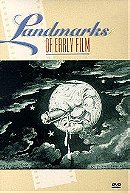
 15
15
 5.7
5.7
 6.3
6.3


